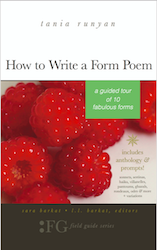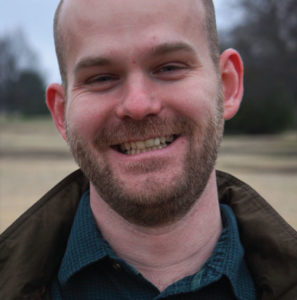Poet-a-Day: Meet Aaron Brown
I consider myself lucky to call Aaron Brown a friend. Having grown up in the north-central African country of Chad, he brings a unique perspective to his life story, conversation, and writing. And his poetry is just plain spectacular, regardless.
That’s why I am honored to have the opportunity to include his “Ghazal” from his award-winning poetry collection, Acacia Road. I’ll include the first few couplets here. If you like it (and I know you will), pick up his book and a copy of How to Read a Form Poem, too, where you can read the poem in its entirety.
Ghazal (an excerpt)
Drums sounding from dream-depths, I sleep to keep safe this city,
to keep dreaming I haven’t yet feared death, felt the loss of this city.
And waking, ever-present dustlight coming through the screen,
I hear the interminable sound of resounding guns across this city.
I dress as the gun-sounds grow, the curtains playing with the breeze
as if shot by a thousand unseen bullets, filled with the silence of this city …
—Aaron Brown
Here’s what the poet himself has to say about his “Ghazal.”
Tania Runyan (TR): Tell me a little about the origin story of your ghazal.
Aaron Brown (AB): This ghazal explores the experiences I had when I was 17 when I watched the nation of my upbringing, Chad, crumble into civil war and violence. I wrote this ghazal attempting to show the multiple events I experienced in 2008, and the new disorienting world of exile and loss that was set into motion when my family fled.
TR: Why did you choose to write this poem as a ghazal? Or did you start out wanting to write a ghazal, and this is the poem that happened?
AB: I fell in love with ghazals during my MFA when I took a poetic forms class with Michael Collier and he introduced me to the work of Agha Shahid Ali. The way the ghazal provides a kind of kaleidoscopic take on loss and grief combined with its steady yet suspended cadence has always resonated with me. After workshopping a previous draft of this poem, I realized that the poem’s repeated phrase, its radif, was weak. That’s when I realized what the poem was doing was mourning a place—the “city”—and the life I had in it that was cut short by war.
Ghazals are always about nailing the rhyme and the radif, and when I switched the phrase to “this city” I felt like the poem was starting to take shape. By the time the poem took its place in my poetry collection Acacia Road, I realized the ghazal was playing a pivotal role in the overall narrative of my book. Just as I was reaching out and attempting to reclaim memories, the ghazal reminded me that the past was being memorialized and mourned at the same time it was being unearthed.
TR: What do you hope poets can learn from a book like How to Write a Form Poem?
I have enjoyed—and taught!—your “How To” books before, and I think having a clear, instructional volume on form poetry will be so helpful for beginning poets dabbling in the sometimes overwhelming world of form poetry. You’ve always done an excellent job providing examples with instruction, and I’m sure this book will demystify and make accessible form poetry for everyone. I’ll certainly be using it myself!
About Aaron Brown
Aaron Brown is the author of the poetry collection, Acacia Road, winner of the 2016 Gerald Cable Book Award (Silverfish Review Press, 2018) and of the memoir, Less Than What You Once Were (Unsolicited Press, 2022). He has published work in Michigan Quarterly Review, Image, World Literature Today online, Waxwing, and Transition, among others, and he is a contributing editor for Windhover. Brown grew up in Chad and now lives in Texas, where he is an assistant professor of English and directs the writing center at LeTourneau University. He holds an MFA from the University of Maryland.
Hear Aaron Read “Ghazal”
go to 24:16 to hear Aaron read
Photo by Ben Allen, Creative Commons, via Flickr. Post by Tania Runyan.
Browse more Poet-a-Day
Browse 50 States of Generosity
Check out The Yellow Wall-paper Graphic Novel
BUY ‘HOW TO WRITE A FORM POEM’ NOW!
- Flowers of California: California Poppy - December 8, 2022
- Flowers of California: Lily of the Nile - October 13, 2022
- Flowers of California: Crape Myrtle - October 5, 2022



Leave a Reply